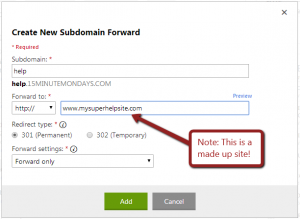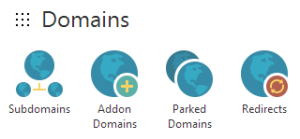
What is a subdomain? It's a great way to create a shorter, more elegant website address to a specific section of your website. Using these, you can give clients (or potential clients) a shorter, more memorable way to get to an area of your website that you're trying to guide them to.
More specifically, a subdomain is a part of your website address that replaces the "www" at the beginning of the address. To be even more specific, www is a subdomain. Yes, that www actually means something, we're just so used to typing it that we don't think about it. The www prefix (or subdomain -- the terms are used almost interchangably) means that this is the part of your website that serves up information to the World Wide Web. So www.example.com is the "website" for the business Example (it's not a real business, it's just an example.)
Why Have a Subdomain?
Now why would you want a subdomain? Let's say you have an area where you sell merchandise. Every item you sell -- be it products at your salon or books and DVDs from your coaching business -- is listed in your "shop." So rather than explaining to someone that your new product is featured at www.mydomain.com/shop or worse "go to www.mydomain.com and in the upper right corner, click on the 'Shop' link," you can simply tell your customers to go to shop.mydomain.com. Or for the online help section of your business, you can tell them to go to help.mydomain.com instead of www.mydomain.com/help or the even more verbose directions mentioned above.
why would you want a subdomain? Let's say you have an area where you sell merchandise. Every item you sell -- be it products at your salon or books and DVDs from your coaching business -- is listed in your "shop." So rather than explaining to someone that your new product is featured at www.mydomain.com/shop or worse "go to www.mydomain.com and in the upper right corner, click on the 'Shop' link," you can simply tell your customers to go to shop.mydomain.com. Or for the online help section of your business, you can tell them to go to help.mydomain.com instead of www.mydomain.com/help or the even more verbose directions mentioned above.
Google is a great example of subdomain use. Beyond the normal www.google.com, I frequently find myself directing my browser to:
- images.google.com
- finance.google.com
- maps.google.com
- news.google.com
- and let's not forget mail.google.com
But memory savings is not the only reason. Using subdomains can also help organize your website or even split your website up and spread it across different server. For example, one server for your main website (www.mydomain.com,) another for your blog (blog.mydomain.com ... possibly at a free blogging site,) and yet another for your online store (shop.mydomain.com ... possibly hosted at one of the many online shopping cart services.)
Another cool feature of subdomains is the ability to use them for services like your shopping cart, blog, or forums which you might change over time. For example, let's say you've just started selling your hand-crafted products through Etsy but have an eye creating your own online gift shop. You can create a subdomain of "shop" so that "shop.mydomain.com" points to your store at Etsy. But later on, when your business has grown and you decide to switch to a high end shopping cart system, you can redirect "shop.mydomain.com" to your new shopping cart. The nice thing about this is that all of the links to your store that you've posted online (on your website, on Facebook, on Pinterest, etc) will automatically point to your new storefront. The same is true for any printed materials like business cards and flyers.
How Do I Create a Subdomain?
Creating your subdomain is a simple process and can be done in a couple of different ways depending on how you have your domain configured (commonly called your DNS settings.)
Subdomain Forwarding at Your Registrar
 The simplest way to use subdomains is through subdomain forwarding at your registrar. Since I use GoDaddy (*this is an affiliate link,) I'll talk specifically about how it works here.
The simplest way to use subdomains is through subdomain forwarding at your registrar. Since I use GoDaddy (*this is an affiliate link,) I'll talk specifically about how it works here.
Go into the My Account section and expand the Domains section. Find the domain you want to work with (in case you have more than one) and click the Launch button. Scroll down under Domain Details until you find the Forwarding section. Click on the Manage link under Subdomains and then click the button for Add Subdomain Forwarding. Type in your subdomain title (like shop, support, help, blog, etc) and the new website address (or URL) that you want to the subdomain to represent. Leave the Redirect Type as "301 (Permanent)" and click add.
Subdomain Creation at Your Web Host
 You can also create subdomains in your cPanel (for WordPress and other hosting options.) This can be slightly trickier because by default cPanel wants to redirect the subdomain somewhere inside your own website such as a subfolder (eg, shop.mydomain.com would point to www.mydomain.com/myproducts.) However, you can redirect it outside your domain if you want.
You can also create subdomains in your cPanel (for WordPress and other hosting options.) This can be slightly trickier because by default cPanel wants to redirect the subdomain somewhere inside your own website such as a subfolder (eg, shop.mydomain.com would point to www.mydomain.com/myproducts.) However, you can redirect it outside your domain if you want.
 Jump into your cPanel and click the Subdomains icon under the Domains heading (see image above and to the right.) Start by creating your new subdomain and pointing it at a subfolder on your website or just at the root of your website if you are goign to redirect it to an outside location (like Etsy or another shopping cart service.) Once you've clicked Create, if you are redirecting to an outside location, click on the small gear (or sprocket) on the subdomain entry and enter a new website address for the subdomain on the Subdomain Redirection page.
Jump into your cPanel and click the Subdomains icon under the Domains heading (see image above and to the right.) Start by creating your new subdomain and pointing it at a subfolder on your website or just at the root of your website if you are goign to redirect it to an outside location (like Etsy or another shopping cart service.) Once you've clicked Create, if you are redirecting to an outside location, click on the small gear (or sprocket) on the subdomain entry and enter a new website address for the subdomain on the Subdomain Redirection page.
The Quick Takeaway
Subdomains can give you flexibility in website organization as well as simplicity in giving out addresses to specific areas of your website. You don't need to over use them by have a subdomain for every area of your website, but using them for major sections like your online store, help documents, and other frequently visited areas can be of great benefit to both you and your customers.